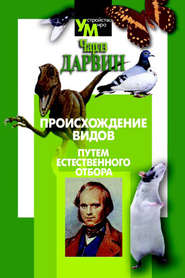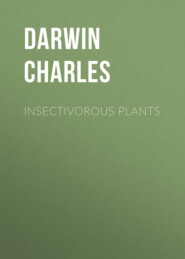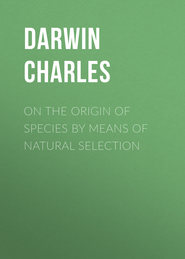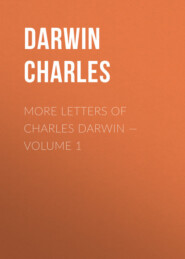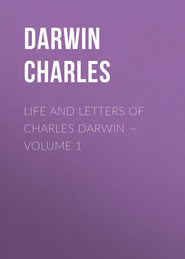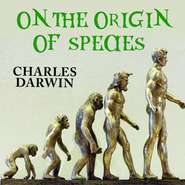По всем вопросам обращайтесь на: info@litportal.ru
(©) 2003-2024.
✖
The Origin of Species by Means of Natural Selection
Настройки чтения
Размер шрифта
Высота строк
Поля
INVERTEBRATA, or INVERTEBRATE ANIMALS. – Those animals which do not possess a backbone or spinal column.
LACUNAE. – Spaces left among the tissues in some of the lower animals and serving in place of vessels for the circulation of the fluids of the body.
LAMELLATED. – Furnished with lamellae or little plates.
LARVA (pl. LARVAE). – The first condition of an insect at its issuing from the egg, when it is usually in the form of a grub, caterpillar, or maggot.
LARYNX. – The upper part of the windpipe opening into the gullet.
LAURENTIAN. – A group of greatly altered and very ancient rocks, which is greatly developed along the course of the St. Laurence, whence the name. It is in these that the earliest known traces of organic bodies have been found.
LEGUMINOSAE. – An order of plants represented by the common peas and beans, having an irregular flower in which one petal stands up like a wing, and the stamens and pistil are enclosed in a sheath formed by two other petals. The fruit is a pod (or legume).
LEMURIDAE. – A group of four-handed animals, distinct from the monkeys and approaching the insectivorous quadrupeds in some of their characters and habits. Its members have the nostrils curved or twisted, and a claw instead of a nail upon the first finger of the hind hands.
LEPIDOPTERA. – An order of insects, characterised by the possession of a spiral proboscis, and of four large more or less scaly wings. It includes the well-known butterflies and moths.
LITTORAL. – Inhabiting the seashore.
LOESS. – A marly deposit of recent (Post-Tertiary) date, which occupies a great part of the valley of the Rhine.
MALACOSTRACA. – The higher division of the Crustacea, including the ordinary crabs, lobsters, shrimps, etc., together with the woodlice and sand-hoppers.
MAMMALIA. – The highest class of animals, including the ordinary hairy quadrupeds, the whales and man, and characterised by the production of living young which are nourished after birth by milk from the teats (MAMMAE, MAMMARY GLANDS) of the mother. A striking difference in embryonic development has led to the division of this class into two great groups; in one of these, when the embryo has attained a certain stage, a vascular connection, called the PLACENTA, is formed between the embryo and the mother; in the other this is wanting, and the young are produced in a very incomplete state. The former, including the greater part of the class, are called PLACENTAL MAMMALS; the latter, or APLACENTAL MAMMALS, include the Marsupials and Monotremes (ORNITHORHYNCHUS).
MAMMIFEROUS. – Having mammae or teats (see MAMMALIA).
MANDIBLES. – in insects, the first or uppermost pair of jaws, which are generally solid, horny, biting organs. In birds the term is applied to both jaws with their horny coverings. In quadrupeds the mandible is properly the lower jaw.
MARSUPIALS. – An order of Mammalia in which the young are born in a very incomplete state of development, and carried by the mother, while sucking, in a ventral pouch (marsupium), such as the kangaroos, opossums, etc. (see MAMMALIA).
MAXILLAE. – in insects, the second or lower pair of jaws, which are composed of several joints and furnished with peculiar jointed appendages called palpi, or feelers.
MELANISM. – The opposite of albinism; an undue development of colouring material in the skin and its appendages.
METAMORPHIC ROCKS. – Sedimentary rocks which have undergone alteration, generally by the action of heat, subsequently to their deposition and consolidation.
MOLLUSCA. – One of the great divisions of the animal kingdom, including those animals which have a soft body, usually furnished with a shell, and in which the nervous ganglia, or centres, present no definite general arrangement. They are generally known under the denomination of "shellfish"; the cuttle-fish, and the common snails, whelks, oysters, mussels, and cockles, may serve as examples of them.
MONOCOTYLEDONS, or MONOCOTYLEDONOUS PLANTS. – Plants in which the seed sends up only a single seed-leaf (or cotyledon); characterised by the absence of consecutive layers of wood in the stem (endogenous growth), by the veins of the leaves being generally straight, and by the parts of the flowers being generally in multiples of three. (Examples, grasses, lilies, orchids, palms, etc.)
MORAINES. – The accumulations of fragments of rock brought down by glaciers.
MORPHOLOGY. – The law of form or structure independent of function.
MYSIS-STAGE. – A stage in the development of certain crustaceans (prawns), in which they closely resemble the adults of a genus (Mysis) belonging to a slightly lower group.
NASCENT. – Commencing development.
NATATORY. – Adapted for the purpose of swimming.
NAUPLIUS-FORM. – The earliest stage in the development of many Crustacea, especially belonging to the lower groups. In this stage the animal has a short body, with indistinct indications of a division into segments, and three pairs of fringed limbs. This form of the common fresh-water CYCLOPS was described as a distinct genus under the name of NAUPLIUS.
NEURATION. – The arrangement of the veins or nervures in the wings of insects.
NEUTERS. – Imperfectly developed females of certain social insects (such as ants and bees), which perform all the labours of the community. Hence, they are also called WORKERS.
NICTITATING MEMBRANE. – A semi-transparent membrane, which can be drawn across the eye in birds and reptiles, either to moderate the effects of a strong light or to sweep particles of dust, etc., from the surface of the eye.
OCELLI. – The simple eyes or stemmata of insects, usually situated on the crown of the head between the great compound eyes.
OESOPHAGUS. – The gullet.
OOLITIC. – A great series of secondary rocks, so called from the texture of some of its members, which appear to be made up of a mass of small EGG-LIKE calcareous bodies.
OPERCULUM. – A calcareous plate employed by many Molluscae to close the aperture of their shell. The OPERCULAR VALVES of Cirripedes are those which close the aperture of the shell.
ORBIT. – The bony cavity for the reception of the eye.
ORGANISM. – An organised being, whether plant or animal.
ORTHOSPERMOUS. – A term applied to those fruits of the Umbelliferae which have the seed straight.
OSCULANT. – Forms or groups apparently intermediate between and connecting other groups are said to be osculant.
OVA. – Eggs.
OVARIUM or OVARY (in plants). – The lower part of the pistil or female organ of the flower, containing the ovules or incipient seeds; by growth after the other organs of the flower have fallen, it usually becomes converted into the fruit.
OVIGEROUS. – Egg-bearing.
OVULES (of plants). – The seeds in the earliest condition.
PACHYDERMS. – A group of Mammalia, so called from their thick skins, and including the elephant, rhinoceros, hippopotamus, etc.
PALAEOZOIC. – The oldest system of fossiliferous rocks.
PALPI. – Jointed appendages to some of the organs of the mouth in insects and Crustacea.
PAPILIONACEAE. – An order of plants (see LEGUMINOSAE), The flowers of these plants are called PAPILIONACEOUS, or butterfly-like, from the fancied resemblance of the expanded superior petals to the wings of a butterfly.
PARASITE. – An animal or plant living upon or in, and at the expense of, another organism.
PARTHENOGENESIS. – The production of living organisms from unimpregnated eggs or seeds.
PEDUNCULATED. – Supported upon a stem or stalk. The pedunculated oak has its acorns borne upon a footstool.
PELORIA or PELORISM. – The appearance of regularity of structure in the flowers of plants which normally bear irregular flowers.






